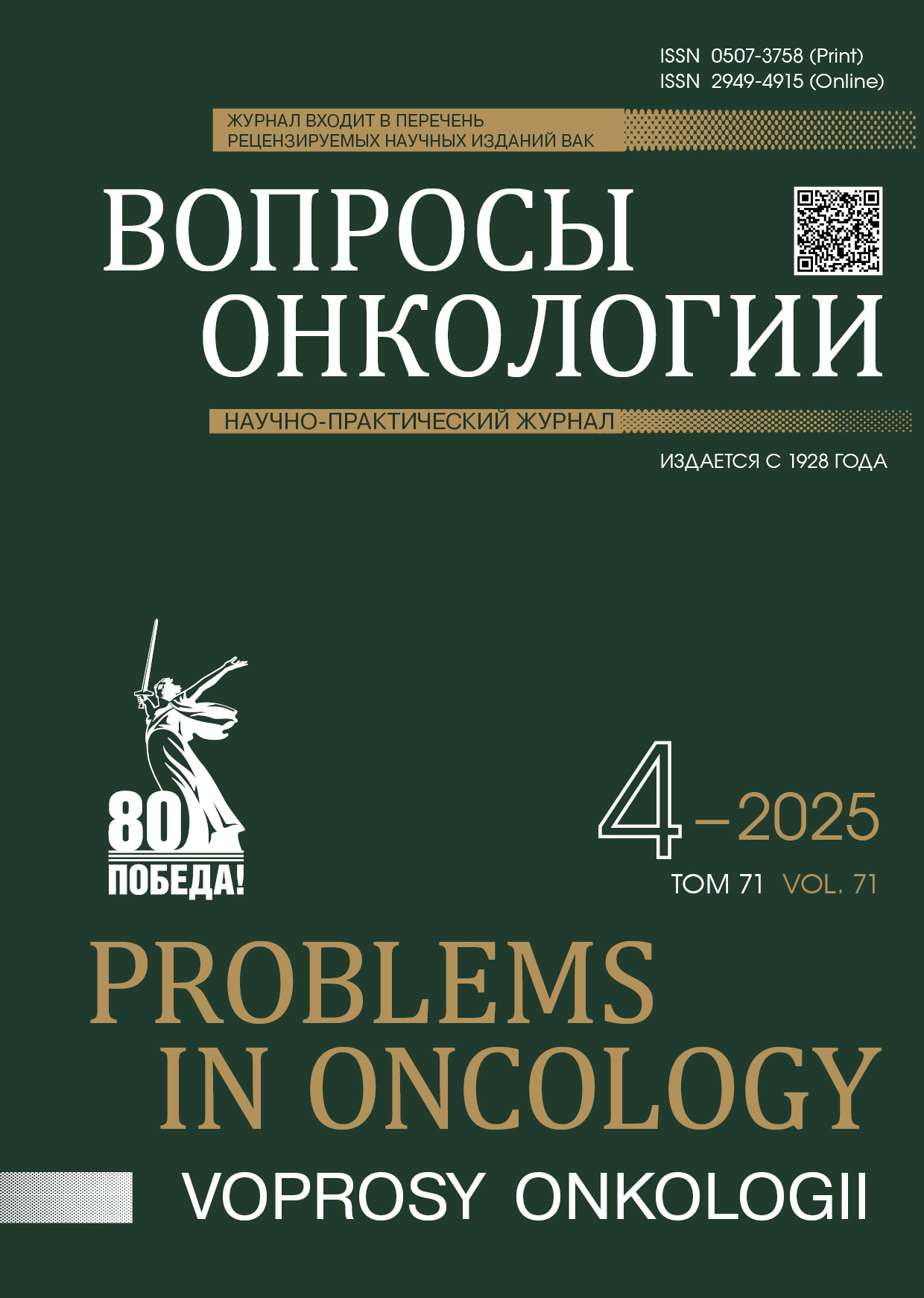Abstract
Introduction. Metastatic uveal melanoma (mUM) has a poor prognosis and limited treatment options. Immune checkpoint inhibitors (ICIs) remain a primary systemic therapy despite their modest efficacy. Combining ICIs with local treatments like stereotactic body radiotherapy (SBRT) or melphalan-based isolated hepatic perfusion (IHP) may synergistically improve outcomes.
Aim. This study evaluates the efficacy and safety of anti-PD-1 monotherapy or anti-PD-1+anti-CTLA-4 combination with SBRT or IHP in mUM patients.
Materials and Methods. This ongoing non-comparative cohort study enrolled treatment-naïve mUM patients aged ≥ 18 years (ECOG 0–1) with ≥1 measurable lesion (RECIST 1.1). Patients received ICIs plus SBRT (for ≤ 3 metastases per organ) or IHP (for liver involvement < 50 %), allowing stable extrahepatic metastases.
Results. From September 2019 to April 2025, 43 patients were enrolled (SBRT group: n=21; IHP group: n=22). SBRT group: Objective response rate (ORR) 42.8 %, 6-month progression-free survival (PFS) 66.7 % (95 % CI 42.5–82.5), median PFS 8.6 months (95 % CI 4.4–13.8), median overall survival (OS) 44.7 months (95 % CI 16.9–NR (Not Reached). IHP group: ORR 45 %, 6-month PFS 72 % (95 % CI 48–86), median PFS 10.1 months (95 % CI 5.0–15.5), median OS not reached. Grade 3–5 adverse events occurred in 14.3 (SBRT) and 45.5 % (IHP).
Conclusion. The combination of ICIs with SBRT or IHP shows promising efficacy and acceptable toxicity in mUM, warranting further investigation.
References
Spagnolo F., Caltabiano G., Queirolo P. Uveal melanoma. Cancer Treat Rev. 2012; 38(5): 549–53.-DOI: 10.1016/j.ctrv.2012.01.002.-URL: https://www.cancertreatmentreviews.com/article/S0305-7372(12)00003-5/fulltext.
Bol K.F., Ellebaek E., Hoejberg L., et al. Real-world impact of immune checkpoint inhibitors in metastatic uveal melanoma. Cancers (Basel). 2019; 11(10): 1489.-DOI: 10.3390/cancers11101489.-URL: https://www.mdpi.com/2072-6694/11/10/1489.
Nathan P., Hassel J.C., Rutkowski P., et al. Overall survival benefit with tebentafusp in metastatic uveal melanoma. New England Journal of Medicine. 2021; 385 (13): 1196–206.-DOI: 10.1056/NEJMoa2103485.-URL: https://www.nejm.org/doi/10.1056/NEJMoa2103485.
Grynberg S., Stoff R., Asher N., et al. Radiotherapy may augment response to immunotherapy in metastatic uveal melanoma patients. Ther Adv Med Oncol. 2022; 14.-DOI: 10.1177/17588359221131521.-URL: https://journals.sagepub.com/doi/10.1177/17588359221131521.
Olofsson Bagge R., Nelson A., Shafazand A., et al. A phase Ib randomized multicenter trial of isolated hepatic perfusion in combination with ipilimumab and nivolumab for uveal melanoma metastases (SCANDIUM II trial). ESMO Open. 2024; 9(7): 103623.-DOI: 10.1016/j.esmoop.2024.103623.-URL: https://www.esmoopen.com/article/S2059-7029(24)01392-9/fulltext.
Nazarova V.V., Orlova K.V., Magomedova Z.R., et al. Combined stereotactic radiation therapy and immunotherapy for metastatic uveal melanoma. Front Oncol. 2025; 15.-DOI: 10.3389/fonc.2025.1567504.-URL: https://www.frontiersin.org/journals/oncology/articles/10.3389/fonc.2025.1567504/full.
Jabbour S.K., Hashem S.A., Bosch W., et al. Upper abdominal normal organ contouring guidelines and atlas: A Radiation Therapy Oncology Group consensus. Pract Radiat Oncol. 2014; 4(2): 82–9.-DOI: 10.1016/j.prro.2013.06.004.-URL: https://www.sciencedirect.com/science/article/pii/S1879850013002622.
Kong F.M. (Spring), Ritter T., Quint D.J., et al. Consideration of dose limits for organs at risk of thoracic radiotherapy: atlas for lung, proximal bronchial tree, esophagus, spinal cord, ribs, and brachial plexus. Int J Radiat Oncol Biol Phys. 2011; 81 (5): 1442–57.-DOI: 10.1016/j.ijrobp.2010.07.1977.-URL: https://www.sciencedirect.com/science/article/pii/S0360301610029512.
Mir R., Kelly S.M., Xiao Y., et al. Organ at risk delineation for radiation therapy clinical trials: Global Harmonization Group consensus guidelines. Radiotherapy and Oncology. 2020; 150: 30–9.-DOI: 10.1016/j.radonc.2020.05.038.-URL: https://doi.org/10.1016/j.radonc.2020.05.038.
Benedict S.H., Yenice K.M., Followill D., et al. Stereotactic body radiation therapy: The report of AAPM Task Group 101. Med Phys. 2010; 37(8): 4078–101.-DOI: 10.1118/1.3438081.
Bisello S., Cilla S., Benini A., et al. Dose–Volume Constraints fOr oRganS At risk In Radiotherapy (CORSAIR): An “all-in-one” multicenter–multidisciplinary practical summary. Current Oncology. 2022; 29(10): 7021–50.-DOI: 10.3390/curroncol29100552.
Grimm J., Marks L.B., Jackson A., et al. High dose per fraction, hypofractionated treatment effects in the clinic (HyTEC): An overview. Int J Radiat Oncol Biol Phys. 2021; 110(1): 1–10. DOI: 10.1016/j.ijrobp.2021.02.042.-URL: https://www.redjournal.org/article/S0360-3016(20)34538-7/fulltext.
Wilke L., Andratschke N., Blanck O., et al. ICRU report 91 on prescribing, recording, and reporting of stereotactic treatments with small photon beams. Strahlentherapie und Onkologie. 2019;195 (3): 193–8.-DOI: 10.1007/s00066-018-1416-x.
Calipel A., Lux A laure, Guérin S., et al. Differential radiosensitivity of uveal melanoma cell lines after x-rays or carbon ions radiation. Investigative Opthalmology & Visual Science. 2015; 56(5): 3085.-DOI: 10.1167/iovs.14-16284.-URL: https://iovs.arvojournals.org/article.aspx?articleid=2295050.
Pan C.C., Kavanagh B.D., Dawson L.A., et al. Radiation-associated liver injury. Int J Radiat Oncol Biol Phys. 2010; 76(3): S94–100.-DOI: 10.1016/j.ijrobp.2009.06.092.
Piulats J.M., Espinosa E., de la Cruz Merino L., et al. Nivolumab plus ipilimumab for treatment-naïve metastatic uveal melanoma: An open-label, multicenter, phase II trial by the spanish multidisciplinary melanoma group (GEM-1402). Journal of Clinical Oncology. 2021; 39(6): 586–98.-DOI: 10.1200/JCO.20.00550.-URL: https://ascopubs.org/doi/10.1200/JCO.20.00550.
Pelster M.S., Gruschkus S.K., Bassett R., et al. Nivolumab and ipilimumab in metastatic uveal melanoma: Results from a single-arm phase II study. Journal of Clinical Oncology. 2021; 39(6): 599–607.-DOI: 10.1200/JCO.20.00605.-URL: https://ascopubs.org/doi/10.1200/JCO.20.00605.

This work is licensed under a Creative Commons Attribution-NonCommercial-NoDerivatives 4.0 International License.
© АННМО «Вопросы онкологии», Copyright (c) 2025

